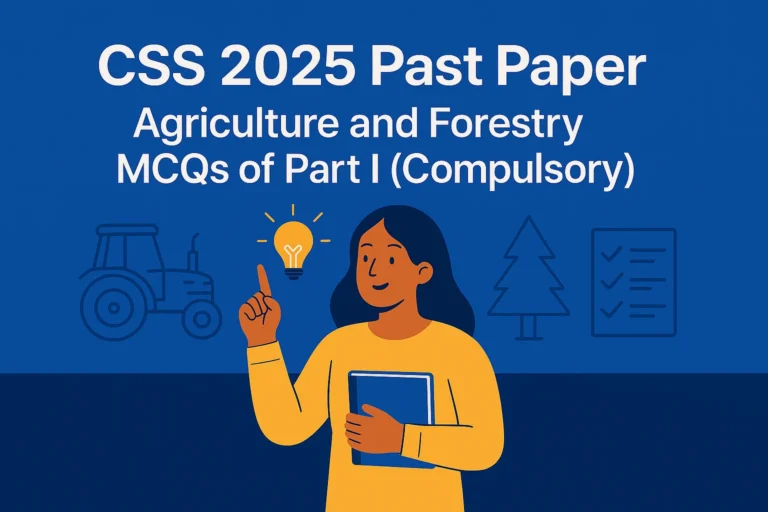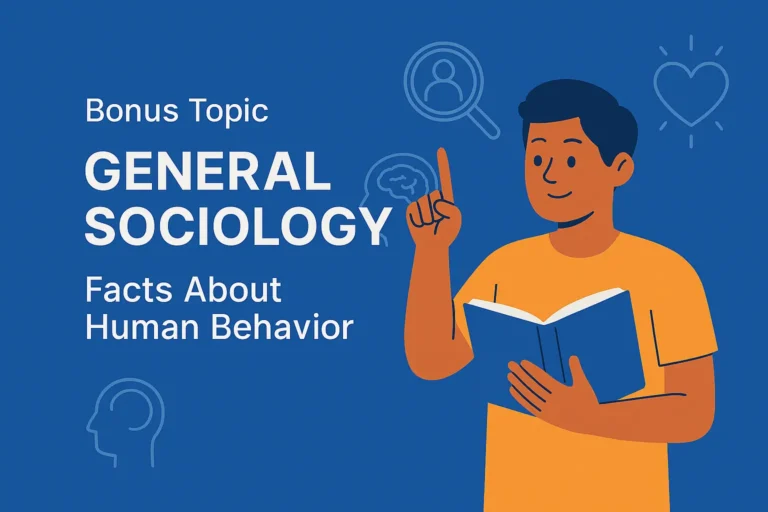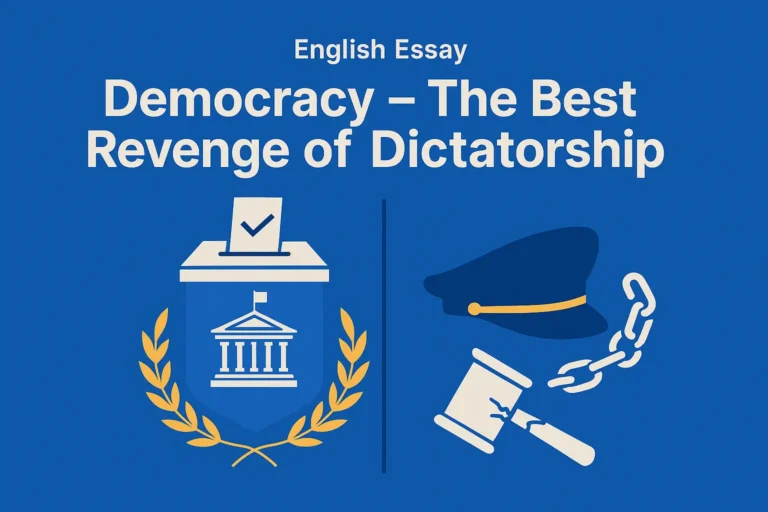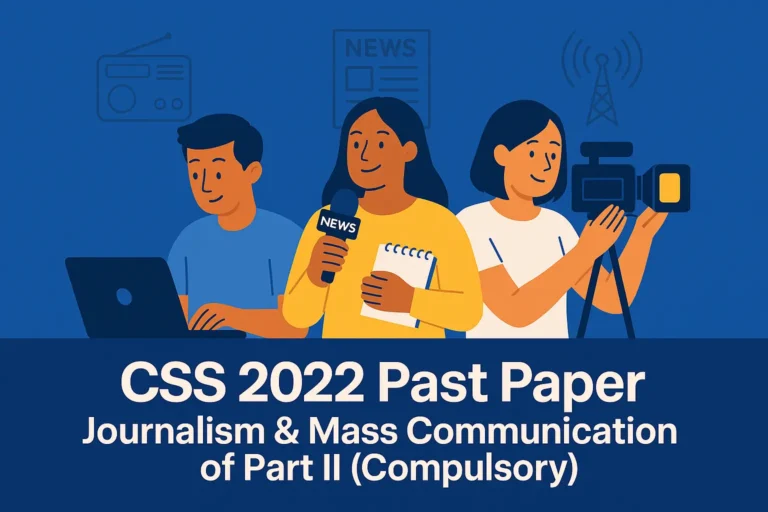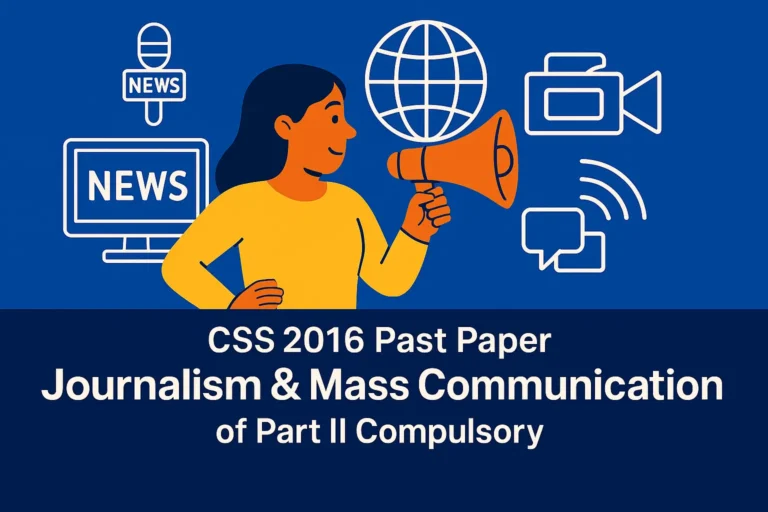CSS Past Paper 2025 Journalism and Mass Communication Descriptive (Part 2)
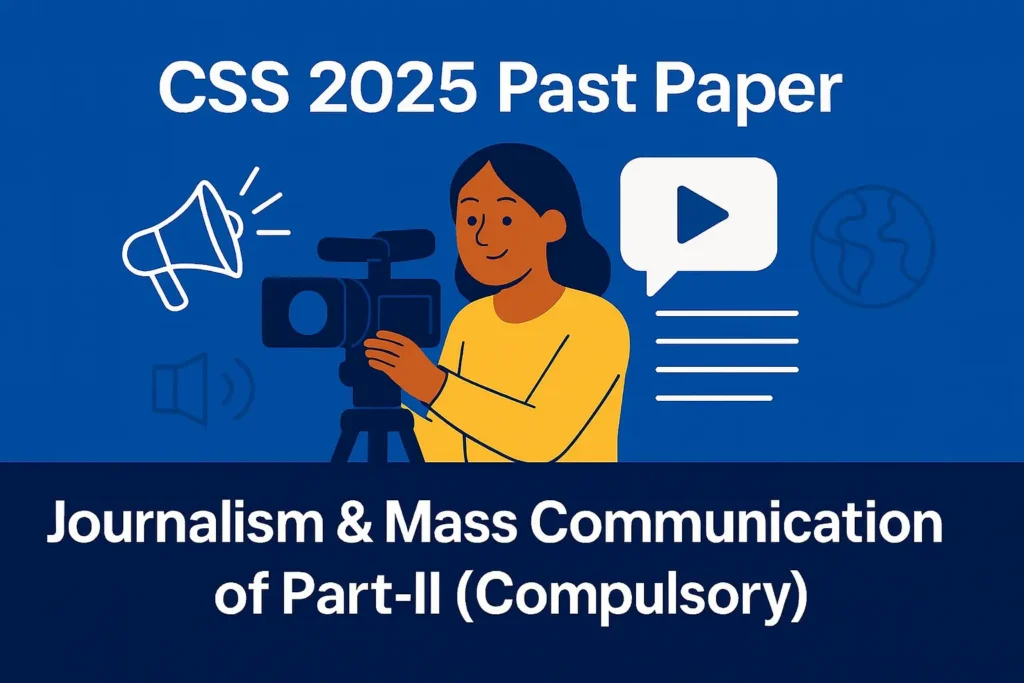
CSS | Past Paper | Group 7 | 2025 | Part 2 | Descriptive
Below is the solution to PART-II (COMPULSORY) of the CSS Past Paper 2025 Journalism and Mass Communication Descriptive (Part 2).
Question 2
Discuss the importance of Media-Government relationship in Democracy. How Government can use media organizations to promote its programs and policies? Support your answer with current relevant examples.
Introduction
Media and government have a very strong link in a democratic country. Both are important parts of the democratic system. Media informs people about the actions of the government, while the government uses media to share its policies and programs. If both work in harmony, it helps democracy grow stronger.
Importance of Media-Government Relationship in Democracy
- Public Awareness:
Media helps people understand what the government is doing. It informs citizens about laws, reforms, policies, and current affairs. - Accountability:
Media keeps a check on government power. It raises questions when something goes wrong. This helps keep the government honest and transparent. - Public Opinion Building:
Through talk shows, articles, and news reports, media creates public opinion. This opinion forces governments to make people-friendly decisions. - Democratic Participation:
Media gives space to all voices—political parties, minorities, women, and civil society. This helps in shaping a healthy democracy. - Crisis Management:
During disasters like floods, earthquakes, or pandemics, media helps in spreading government alerts and messages quickly.
How Government Can Use Media to Promote Its Programs and Policies
- Press Conferences and Media Briefings:
Governments can inform journalists about their policies through regular press talks. For example, Pakistan’s Ministry of Information often holds press conferences to explain government steps. - Public Service Announcements (PSAs):
The government can run awareness campaigns on TV, radio, and social media. For example, the Ehsaas Program was promoted through TV ads to educate the public. - Social Media Platforms:
Now many politicians and institutions use platforms like X (formerly Twitter), Facebook, and YouTube. For example, during COVID-19, the Government of Pakistan used social media to inform people about SOPs and vaccination centers. - State-Owned Media:
PTV and Radio Pakistan are state-run media channels. The government uses these platforms to promote national policies, cultural values, and development goals. - Paid Advertisements:
Govt. departments publish advertisements in newspapers and digital media to explain their schemes. For example, BISP (Benazir Income Support Program) and PM Youth Loan Scheme were promoted through newspapers.
Relevant Examples (2023-2025)
- Green Pakistan Initiative: Govt. used TV and social media to promote tree plantation and climate awareness.
- Roshan Digital Account: SBP used media to encourage overseas Pakistanis to invest in Pakistan.
- Anti-Narcotics Campaigns: The Ministry of Narcotics Control used FM radio and TV ads to highlight dangers of drug use.
- Digital Census 2023: Government ran awareness messages on all platforms to ensure full participation.
Conclusion
Media and government are like two wheels of the democratic cart. If their relationship is based on transparency, mutual respect, and professionalism, then democracy flourishes. But if media becomes a tool for propaganda, it can damage the democratic values. So, governments should use media responsibly to spread awareness, and not just to build fake images.
Question 3
Briefly narrate the historical evolution of Media Laws and Ethics in Pakistan.
Introduction
Media laws and ethics in Pakistan have a long journey starting from independence in 1947 till today. These laws were shaped by political situations, military regimes, democratic governments, and the rise of private media. Ethics guide how media should behave, while laws control what media can or cannot do. Both are important to keep media free but also responsible.
Early Years (1947–1958)
- After independence, Pakistan inherited British colonial laws like the Press and Publication Act 1918, Official Secrets Act 1923, and Defamation Laws.
- The media was weak and mostly state-controlled.
- Journalists had little protection, and there were no strong ethical codes.
Ayub Era (1958–1969)
- General Ayub Khan introduced Press and Publication Ordinance (PPO) 1963.
- It gave government full control over press. Newspapers could be shut down easily.
- This period was tough for free journalism. Censorship increased.
- The idea of media ethics started to grow but under pressure.
Bhutto Era (1971–1977)
- Zulfiqar Ali Bhutto gave some freedom to media but also nationalized major newspapers like Pakistan Times.
- TV and radio remained under govt. control (PTV and Radio Pakistan).
- Journalists started organizing themselves, and unions became stronger.
Zia Era (1977–1988)
- General Zia-ul-Haq imposed strict censorship.
- He used Martial Law regulations to punish journalists.
- Religious content was controlled, and media had to promote Islamic values.
- Media ethics were often used as a tool to control press freedom.
Democratic Era (1988–1999)
- Benazir Bhutto and Nawaz Sharif gave some space to the press.
- New newspapers and magazines came into the market.
- Ethics codes were discussed more openly in media circles.
- Still, there was no proper law to protect media freedom.
Musharraf Era (1999–2008)
- A turning point in Pakistan’s media history.
- General Musharraf allowed private TV channels like Geo, ARY, Dunya etc.
- Created PEMRA Ordinance 2002 to regulate electronic media.
- Media grew fast, but PEMRA was also used to ban channels when needed.
- Press freedom improved, but control remained.
Democratic Governments (2008–2018)
- Many new laws and discussions happened in this period.
- Right to Information laws were passed in provinces.
- PEMRA became more active, but sometimes biased.
- Ethical codes were introduced by PFUJ, CPNE and media houses.
- Fake news, sensationalism, and privacy violations increased, showing weak ethics enforcement.
Recent Years (2019–2025)
- Govt. introduced Citizens Protection (Against Online Harm) Rules 2020 under PTA.
- Social media laws became strict.
- Journalists face threats, FIRs, and abductions.
- Ethics codes still exist but not always followed.
- Media watchdogs like Reporters Without Borders raised concerns about press freedom.
- In 2023–25, there have been talks about Digital Media Regulations, but journalists fear more censorship.
Key Ethical Principles in Pakistani Media
- Truth and accuracy
- Respect for privacy
- No hate speech or incitement
- Fair reporting
- Separation of news and opinion
- Avoid fake news and propaganda
Conclusion
The evolution of media laws and ethics in Pakistan shows a struggle between freedom and control. From colonial laws to digital regulations, the journey is full of ups and downs. Pakistan needs balanced laws that protect media freedom but also ensure ethical journalism. Without strong ethical values, freedom can turn into chaos. And without freedom, media becomes just a loudspeaker of the powerful.
Question 4
What is New Social Media? Narrate its importance in Internet Age. Also suggest some ethical guidelines to make it compatible with developed world.
Introduction
New Social Media means modern online platforms where people can create, share, and exchange information quickly. Examples are Facebook, X (Twitter), Instagram, YouTube, WhatsApp, TikTok, Snapchat, and others. Unlike traditional media (TV, radio, newspapers), social media is two-way — users are both consumers and producers of content.
What is New Social Media?
It refers to websites and mobile apps that allow interaction, sharing, and participation through the internet. People can post videos, photos, opinions, news, and even go live. It is real-time and global.
Popular Platforms:
- YouTube
- TikTok
- X (formerly Twitter)
Types of Content Shared:
- News and political opinions
- Entertainment and memes
- Educational videos
- Personal updates
- Business and marketing content
Importance of New Social Media in the Internet Age
- Fast Information Sharing
News spreads in seconds. For example, during the 2022 floods in Pakistan, people shared updates and videos before any news channel did. - Public Participation in Politics
Social media gives voice to common people. Movements like Aurat March or campaigns like #JusticeForZainab gained support online. - Education and Learning
Students use YouTube for lectures, TikTok for language learning, and WhatsApp groups for notes. - Business and Marketing
Small businesses grow fast using Facebook pages or Instagram ads. Many people earn through content creation now. - Connecting the World
A student in Balochistan can talk to someone in Canada instantly. It makes the world feel smaller and more connected. - Citizen Journalism
People now report events themselves using mobile phones. This is helpful in areas where mainstream media doesn’t reach.
Challenges of New Social Media in Pakistan
- Fake News & Misinformation
Rumors spread fast. In 2023, false news about exam delays caused panic among students. - Hate Speech & Cyberbullying
Online abuse, especially against women and minorities, is rising. - Lack of Digital Literacy
Many users don’t know how to verify news or protect their privacy. - Political Propaganda
Social media is used to spread biased views and target opponents. - Mental Health Issues
Addiction to social media, comparison, and online hate affects youth negatively.
Ethical Guidelines for Social Media (To Match Developed World Standards)
- Fact-Checking Before Sharing
Users should verify news from trusted sources before reposting. - Respect for Privacy
Don’t post someone’s personal photos or videos without permission. - No Hate Speech or Harassment
Online platforms should ban accounts spreading racism, sectarianism, or threats. - Balanced Content
Avoid spreading extreme political views or one-sided opinions. - Transparency in Sponsored Content
Influencers should clearly mention if a post is paid or promotional. - Promote Positive Use
Encourage educational, health-related, and skill-building content. - Regulate Algorithms
Social media companies should stop pushing only viral or negative content for profit.
Conclusion
New social media is a powerful tool in the internet age. It connects people, spreads knowledge, and gives freedom of speech. But without ethics, it can also harm society. Pakistan needs awareness campaigns, digital literacy, and proper rules to use social media in a healthy way — just like developed countries. The goal should be a free yet responsible digital space.
Question 5
What is the current situation of Freedom of Expression in Pakistan in 2025? Also discuss various threats and challenges faced by Journalists.
Introduction
Freedom of expression is a basic right given by Article 19 of the Constitution of Pakistan. It allows citizens, especially journalists, to express opinions freely without fear. But in 2025, the situation is not very good. Journalists are facing many threats, and freedom of speech is limited in many ways.
Current Situation of Freedom of Expression in Pakistan (2025)
- Limited Space for Dissent
Voicing criticism against powerful institutions, especially the military and judiciary, can lead to legal trouble, bans, or even arrest. - Censorship and Bans
Many news channels and social media accounts were blocked in recent years. For example, in 2024, some anchors’ YouTube channels were taken down for criticizing the government. - Laws Used to Silence Critics
Laws like PECA (Prevention of Electronic Crimes Act) are being misused to file cases against journalists, bloggers, and social media activists. - Fear and Self-Censorship
Journalists avoid covering sensitive topics like missing persons, corruption, or religious issues. They fear backlash or violence. - Control on Social Media
Government is making new rules to monitor digital platforms. Some activists say this is just to control freedom of expression online. - International Ranking
According to Reporters Without Borders, Pakistan’s press freedom ranking has dropped in 2025. It’s considered one of the most dangerous countries for journalists in Asia.
Threats and Challenges Faced by Journalists
- Physical Attacks
Journalists are kidnapped, beaten, or even killed. For example, Arshad Sharif, a senior journalist, was shot dead in 2022, and the case is still unsolved. - Legal Harassment
FIRs and court cases are used to scare journalists. Even peaceful tweets or articles can lead to long legal fights. - Online Harassment
Female journalists especially face trolling, threats, and abuse on platforms like X (Twitter) and Facebook. - Job Insecurity and Low Pay
Many media houses fire workers or delay salaries. This weakens journalists economically and makes them more vulnerable to pressure. - Lack of Safety Laws
Though there is a Journalist Protection Law, its implementation is weak. Police often ignore complaints made by journalists. - Political Pressure
Governments use advertisement funding as a tool. Media houses are forced to either follow the government’s narrative or lose revenue. - Missing Persons & Forced Silence
Some journalists and bloggers go missing for weeks or months. Families stay quiet out of fear. These cases are rarely solved.
Recent Examples (2023–2025)
- In 2023, journalist Imran Riaz Khan disappeared and returned after months, but never explained what happened.
- In 2024, several YouTube channels discussing political cases were banned.
- Coverage of Balochistan and KP issues is still limited due to pressure from security agencies.
Conclusion
In 2025, freedom of expression in Pakistan is under serious threat. Journalists are working in fear, and real journalism is slowly disappearing. To improve this, the government should protect journalists, reform media laws, and stop using censorship. Without freedom of speech, democracy cannot grow, and people will stay unaware of the truth.
Question 6
What is Social Change? Narrate with examples of private television dramas in creating social and cultural changes in Pakistan.
Introduction
Social change means any kind of shift in the behavior, values, traditions, or lifestyle of people in a society. It can be slow or fast, and it often happens due to education, technology, media, or law. In Pakistan, private television dramas have played a big role in spreading new ideas and changing people’s thinking, especially in cities.
What is Social Change?
Social change is the transformation of society over time. It affects how people think, act, and live. It can be positive (like ending child marriage) or negative (like rise in materialism).
Main Causes of Social Change
- Education
- Mass media
- Urbanization
- Technology
- Globalization
- Political movements
Role of Private TV Dramas in Social and Cultural Change
After 2000, many private TV channels like Geo, Hum TV, ARY Digital, Express, etc. started airing quality dramas. These dramas reach millions and show stories that touch common people’s lives.
Examples of Dramas That Brought Social Change
- “Udaari” (Hum TV)
- Topic: Child abuse
- Impact: Broke the silence around child sexual abuse. People started talking about this hidden issue.
- Govt. and NGOs used this drama to promote child safety awareness.
- “Zindagi Gulzar Hai” (Hum TV)
- Topic: Women’s education, class difference
- Impact: Encouraged girls to complete education and work hard for success.
- Showed that girls from middle-class homes can achieve dreams.
- “Baaghi” (Urdu 1)
- Topic: Honor killing, women’s freedom
- Impact: Based on Qandeel Baloch’s real story. Opened debates on women’s rights and fake “honor” culture.
- “Dar Si Jati Hai Sila” (Hum TV)
- Topic: Sexual harassment in homes
- Impact: Showed that abusers can be family members too. Pushed people to trust children and speak up.
- “Pyar Ke Sadqay” (Hum TV)
- Topic: Emotional abuse and toxic parenting
- Impact: Highlighted how mental abuse is real and damaging.
- “Ehd-e-Wafa” (Hum TV & ISPR)
- Topic: Patriotism, youth responsibilities
- Impact: Encouraged youth to work for Pakistan’s development in different fields.
- “Meray Paas Tum Ho” (ARY)
- Topic: Love, betrayal, and materialism
- Impact: Sparked national debate on marriage values and loyalty. Though criticized for being one-sided, it changed the conversation.
Positive Social Effects of TV Dramas
- Women Empowerment: Many dramas show strong female leads. This encourages girls to be independent.
- Taboo Breaking: Issues like rape, harassment, and mental health are now openly shown.
- Raising Awareness: About legal rights, education, gender equality, and poverty.
- Cultural Change: Urban stories influence rural viewers too, changing mindsets slowly.
- Dialogue Starter: Families discuss issues shown in dramas at home.
Criticism of Private TV Dramas
- Some focus too much on love stories and family fights.
- Many show toxic male behavior as normal.
- Sometimes, they promote upper-class lifestyles, ignoring poor people’s issues.
- Commercial pressure makes channels pick ratings over real stories.
Conclusion
Private TV dramas are powerful tools for social change in Pakistan. They reach every home and touch people emotionally. Though not all dramas are perfect, many have raised awareness, changed thinking, and started important conversations in society. If used with responsibility, Pakistani dramas can continue playing a positive role in shaping a better and more informed society.
Question 7
Discuss the role of Development Support Communication in Educational uplift and fighting against illiteracy in Pakistan. Provide suitable examples from National Context.
Introduction
Development Support Communication (DSC) means using media and communication tools to support national development. It helps educate people, change behaviors, and spread awareness. In Pakistan, DSC plays a major role in promoting education and fighting illiteracy, especially in rural and backward areas.
What is Development Support Communication (DSC)?
DSC is planned communication used by governments, NGOs, or institutions to spread messages that lead to development in areas like health, education, agriculture, etc.
Key Features
- Two-way communication
- Targeted messages
- Use of radio, TV, social media, posters, SMS, etc.
- Behavior change is the main goal
Educational Uplift through DSC in Pakistan
- Awareness Campaigns
- Many awareness ads on TV, radio, and newspapers tell parents to send kids to school.
- Example: “Parho Punjab, Barho Punjab” campaign by Punjab govt increased school enrollments.
- Use of Educational TV and Radio
- During COVID-19, “TeleSchool” was launched for students with no internet. It gave lectures from KG to Matric level.
- Radio Pakistan also aired lessons for students in remote areas.
- Adult Literacy Programs
- DSC helped promote adult education.
- For example, National Commission for Human Development (NCHD) used posters, pamphlets, and community meetings to educate elders in villages.
- Girls’ Education Campaigns
- NGO and govt. campaigns encouraged parents to send girls to school.
- “Girls Not Brides” and “Let Girls Learn” projects were promoted through TV ads, local theater, and influencers.
- Use of Mobile Phones
- Apps like Taleemabad and Ilm Ki Duniya were advertised on TV and downloaded by thousands of parents.
- SMS alerts remind parents about school admissions and exams.
- YouTube & Social Media Channels
- DSC now uses social media. Many YouTubers and pages like Maati TV or Taleem Ghar promote free education videos.
- Education Boards also post updates on Facebook and X (Twitter) to stay connected with students.
Fighting Illiteracy through DSC
- Language-Specific Content
- DSC in Urdu, Punjabi, Sindhi, Pashto, and Balochi helps people understand better.
- Example: Sindh Education Foundation created videos and booklets in Sindhi.
- Use of Religious Messaging
- Some campaigns used Islamic quotes like “Ilm hasil karna har Musalman par farz hai” to convince elders.
- Door-to-Door Communication
- NGOs like Alif Ailaan used field workers to talk to parents and explain why education matters.
- Involving Celebrities
- Actors, singers, and cricket stars appeared in ads promoting literacy, making the message more powerful.
- School Enrollment Drives
- DSC supported massive drives before school years, using banners, rallies, radio messages, etc.
Challenges in DSC for Education
- Low budget for communication campaigns
- Weak access to internet in rural areas
- Lack of trained communication staff
- Political interference in message design
- Short-term efforts instead of continuous campaigns
Conclusion
Development Support Communication is a strong weapon against illiteracy in Pakistan. It helps spread awareness, motivate people, and promote positive behavior towards education. From TV ads to mobile apps, every communication tool can help bring a real change. With better planning and more focus on rural areas, DSC can support Pakistan in achieving 100% literacy in the future.
Question 8
Write notes on any TWO of the following:
a. Media, as an agent of Social Change
b. Globalization and Media
c. Gerbner’s model of Communication
a. Media as an Agent of Social Change
Introduction
Media is one of the strongest forces that can change the way people think, live, and behave. It shapes public opinion, breaks taboos, and brings attention to social issues. In a developing country like Pakistan, media has helped to modernize society and promote awareness.
How Media Brings Social Change?
- Raising Awareness
Media highlights problems like poverty, child marriage, women’s rights, and education. This makes people more aware and active. - Changing Mindsets
Dramas, films, and talk shows challenge old traditions. For example, dramas like Udaari and Dar Si Jati Hai Sila helped change thinking about child abuse and harassment. - Educational Content
Channels like PTV, Geo, and social media platforms offer informative programs on health, religion, and education. - Political Participation
Talk shows and election coverage help citizens understand their rights and the political process. - Women Empowerment
Media shows strong female characters, promotes girls’ education, and highlights successful women in society. - Emergency Alerts and Campaigns
During disasters or pandemics, media shares quick updates and safety guidelines.
Conclusion
Media plays a key role in modernizing society. It gives voice to the voiceless and helps people accept change. But it must also act responsibly to avoid spreading fake news or harmful content.
b. Globalization and Media
Introduction
Globalization means the world is becoming more connected in terms of culture, economy, politics, and communication. Media is the main tool that spreads global trends, news, and values across borders.
Role of Media in Globalization
- Instant Communication
News from one corner of the world spreads globally in minutes through channels like BBC, CNN, and Al Jazeera. - Cultural Exchange
People in Pakistan watch Turkish dramas, Hollywood movies, and Indian songs. Similarly, Pakistani shows are now seen worldwide. - Economic Impact
Global ads, e-commerce, and international markets are promoted through media. Multinational brands use local media to attract customers. - Social Media Platforms
Apps like Facebook, X (Twitter), TikTok, and Instagram connect people worldwide. They help share ideas, cultures, and events. - Global Movements
Hashtags like #BlackLivesMatter or #FreePalestine show how media can create global unity and pressure for justice.
Positive Effects
- Learning new cultures
- Improving technology use
- Promoting tourism and economy
- Better global understanding
Negative Effects
- Western cultural dominance
- Loss of local traditions and languages
- Spread of fake news worldwide
Conclusion
Globalization and media go hand in hand. Media acts as a bridge between cultures. Pakistan should use this opportunity to show its positive image while also protecting its own identity.
c. Gerbner’s Model of Communication
Introduction
George Gerbner was a famous communication theorist who gave a model in 1956 that explains the process of communication clearly. His model focuses on how a message is produced, sent, received, and understood.
Main Elements of Gerbner’s Model
- E (Event) – The real-world happening
- M (Man or Machine) – The person or tool that sees the event
- SE (Signal/Event) – The message about the event
- C (Content) – What is being communicated
- P (Perception) – How the receiver understands the message
Explanation of the Process
Let’s say there’s a protest (Event). A reporter (M) sees it and reports it. That report becomes the signal (SE), which is sent through TV (channel). The viewer (receiver) watches it and forms an opinion (P).
Key Features
- It focuses on perception.
- It shows that communication is not just sending but also understanding.
- It can be used for both personal and mass communication.
Application in Media
- News reporting
- Advertisements
- Public awareness campaigns
Conclusion
Gerbner’s model is simple and practical. It shows that how a message is seen and received matters a lot. It also tells us that communication is not just about talking — it’s about understanding too.
📘 Benefits of Practicing This Descriptive Paper
- ✅ These CSS Past Paper 2025 Journalism and Mass Communication Descriptive questions are compiled from authentic FPSC CSS past papers, following the real written exam format.
- 💬 Attempting this CSS Past Paper 2025 Journalism and Mass Communication Descriptive helps students master structured writing and analytical skills for CSS exams.
- 🧾 Every question in this CSS Past Paper 2025 Journalism and Mass Communication Descriptive strictly follows the official CSS exam syllabus approved by FPSC.
- 📊 Students preparing for CSS 2025 can rely on this CSS Past Paper 2025 Journalism and Mass Communication Descriptive to practice time management and topic selection.
- 🔍 The solved CSS Past Paper 2025 Journalism and Mass Communication Descriptive contains concise explanations to improve conceptual understanding and writing clarity.
- 🎯 Regular revision of this CSS Past Paper 2025 Journalism and Mass Communication Descriptive builds confidence and strengthens your preparation for the CSS written paper.
- 🏆 This CSS Past Paper 2025 Journalism and Mass Communication Descriptive is essential for mastering exam techniques and achieving success in the FPSC CSS examination.
🏁 Final Note
Keep revising these CSS Past Paper 2025 Journalism and Mass Communication Descriptive to strengthen your grip on important concepts and improve accuracy in upcoming CSS exams. Regular practice with these CSS Past Paper 2025 Journalism and Mass Communication Descriptive will help you score higher and build full command over the CSS exam syllabus.
👉 Also read CSS Past Paper 2025 Journalism and Mass Communication (Part-I MCQs)
🔗 Check FPSC past papers directly from the official FPSC website.

